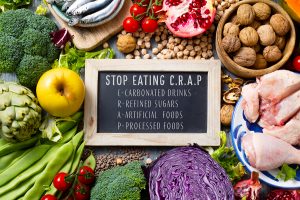 Your doctor may have told you to eat healthy food and avoid eating processed foods. But what does that mean, exactly? Nuts are usually roasted and salted, are they processed? What about bread, it comes out of a factory and goes into a package?
Your doctor may have told you to eat healthy food and avoid eating processed foods. But what does that mean, exactly? Nuts are usually roasted and salted, are they processed? What about bread, it comes out of a factory and goes into a package?
For that matter, are eggs, milk and cheese considered processed? Of course they are. It gets confusing. Some processed foods aren’t bad for you, others are. Which is which? I turned to an excellent article written by Andy Bellatti MS, RD and published on Elemental.medium.com to understand what processed food means.
The United States Department of Agriculture (USDA) provides a legal and technical definition of a processed food:
“Any raw agricultural commodity that has been subject to washing, cleaning, milling, cutting, chopping, heating, pasteurizing, blanching, cooking, canning, freezing, drying, dehydrating, mixing, packaging or other procedures that alter the food from its natural state. This may include the addition of other ingredients to the food, such as preservatives, flavors, nutrients, and other food additives or substances approved for use in food products, such as salt, sugars, and fats.”
When nutrition experts talk about packaged foods, they refer to foods that have been processed to such a degree that there’s been significant nutrient loss and/or a significant addition of unhealthy ingredients (mainly in the form of added sugars, oils, or salt).
Four Kinds of Processed Foods
The NOVA food classification system, developed by an international panel of scientists and public health leaders, helps to differentiate minimally processed foods that are not harmful to health from highly processed (also called “ultra-processed”) foods that have a detrimental effect on human health.
NOVA divides foods into four groups, based on the amount of processing they have undergone:
Group 1: Unprocessed, or minimally processed, foods
Defined as: “edible parts of plants (seeds, fruits, leaves, stems, roots) or of animals (muscle, offal, eggs, milk), and also fungi, algae, and water, after separation from nature.”
Group 2: Processed culinary ingredients
Defined as: “oils, butter, sugar, and salt, are substances derived from Group 1 foods or from nature by processes that include pressing, refining, grinding, milling, and drying.”
Group 3: Processed foods
Defined as: “Processed foods, such as bottled vegetables, canned fish, fruits in syrup, cheeses, and freshly made breads, are made essentially by adding salt, oil, sugar, or other substances from Group 2 to Group 1 foods.”
Group 4: Ultra-processed foods
Defined as: “Ultra-processed foods, such as soft drinks, sweet or savory packaged snacks, reconstituted meat products, and pre-prepared frozen dishes, are not modified foods but formulations made mostly or entirely from substances derived from foods and additives, with little if any intact Group 1 food.”
NOVA goes on to state: “The overall purpose of ultra-processing is to create branded, convenient (durable, ready to consume), attractive (hyper-palatable), and highly profitable (low-cost ingredients) food products designed to displace all other food groups. Ultra-processed food products are usually packaged attractively and marketed intensively.”
Why Avoid the Ultra Processed Group?
Recent studies have concluded that higher consumption of ultra-processed foods is associated with:
- Excess risks of cardiovascular disease and all-cause mortality
- Higher risks of cardiovascular, coronary heart, and cerebrovascular diseases
- Increased risks of total and breast cancers
- Higher risk of overweight and obesity
Foods that are Ultra-processed are commonly high in added salt and sugar. High-sodium diets have repeatedly and consistently been linked with increased risk of stroke and total cardiovascular disease. The science demonstrating the harmful effects of added sugar is also prevalent, so much so that, in 2016, the U.S. Food and Drug Administration (FDA) mandated that added sugar—along with a percentage of the daily value recommended as a limit—be added to the nutrition facts panel in the United States.
Perhaps even more important, overly-processed foods are stripped of a significant amount of the health-promoting components (fiber, phytonutrients, vitamins, and minerals) found in the original whole food.
The loss of these nutrients can take a toll on overall health. Dietary fiber, for example, confers a variety of health benefits, including lowering blood pressure and heart disease risk as well as lowering incidences of colon cancer.
The negative health impacts of eating a diet high in the ultra-processed group is clear. Yet approximately 60% of the daily calories consumed by the average American are from these overly-refined foods.
The Golden Rule:
Always prefer natural or minimally processed foods and freshly made dishes and meals to other products.
Opt for water, milk, and fruits instead of soft drinks, dairy drinks, and biscuits. Do not replace freshly prepared dishes (broths, soups, salads, sauces, rice and beans, pasta, steamed vegetables, pies) with products that do not require culinary preparation (packaged snacks and soups, instant noodles, pre-prepared frozen dishes, sandwiches, cold cuts and sausages, industrialized sauces, ready-mixes for cakes). Choose homemade desserts and avoid industrialized formulations.

Recent Comments